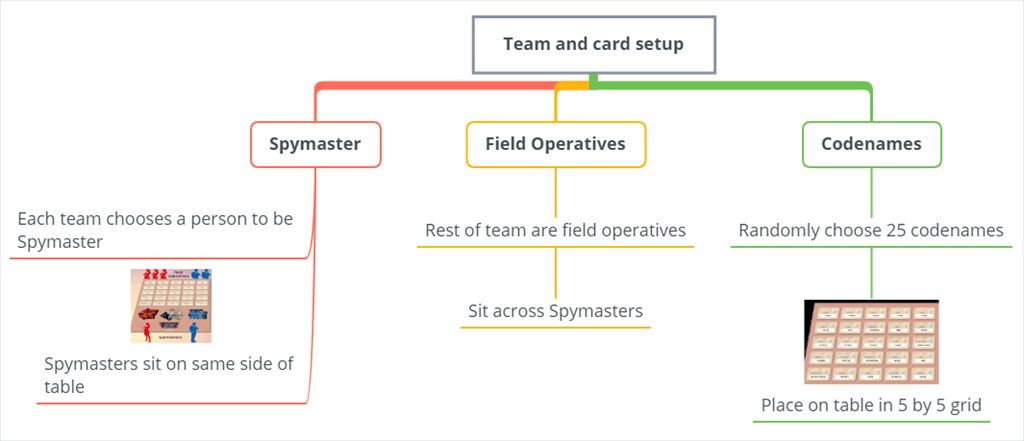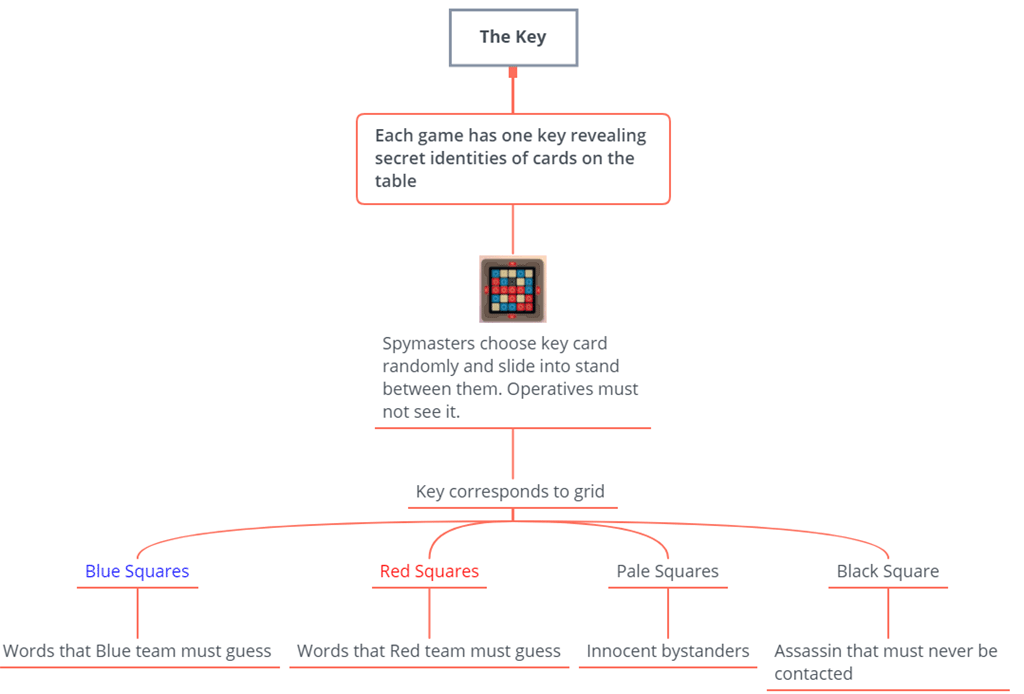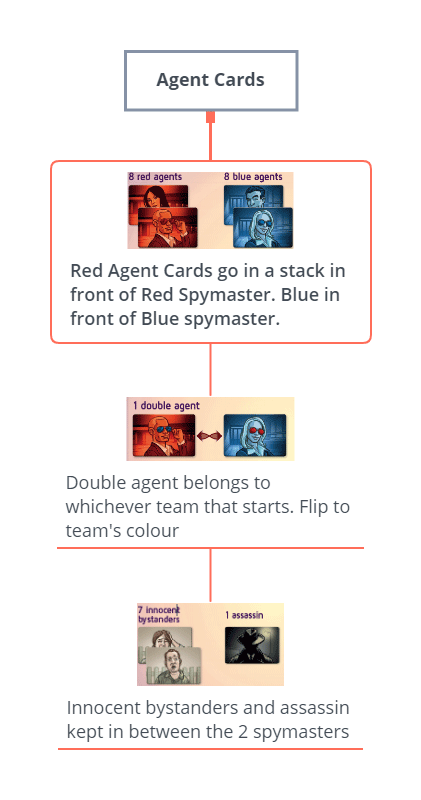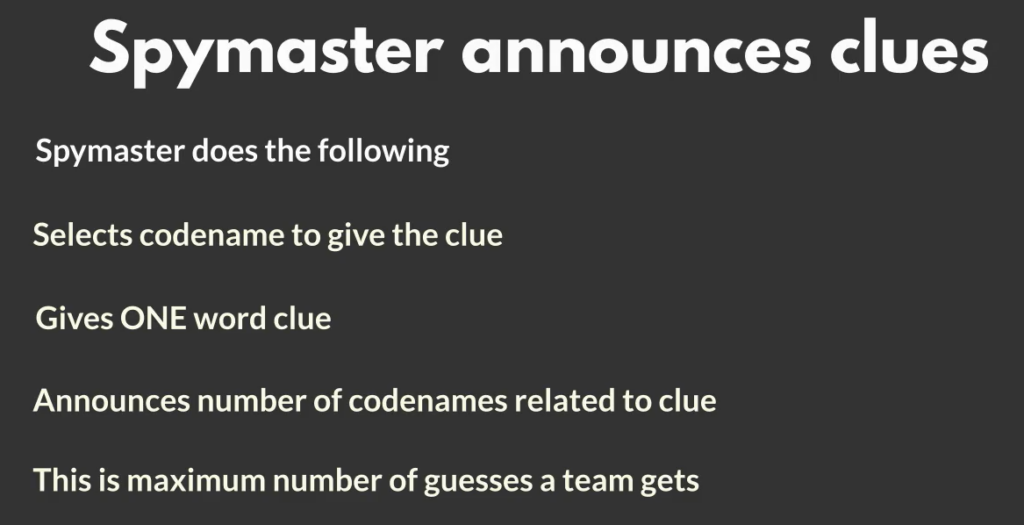How to Play Codenames Game Rules if you hate rulebooks
I hate rulebooks. This rules guide was made to help you get the instructions on how to play Codenames as quick and straight-forward as possible.
What is the goal?
- Players split into 2 teams, with each team assigning a Spymaster
- There are 25 codenames (words) on the table
- The Spymasters of each team know the identity of the agents hiding behind the codenames
- Spymasters must guide each team to guess the codenames of their team’s agents by providing a clue to them
- Teams use the clue to guess the right codenames related to their team’s agents
- Be careful, choose the Assasin agent and you lose
- Winning team is the team that uncovers the identities of all their agents
Codenames Game Setup
How do you setup Codenames teams and cards?
- Choose Spymasters
- Each team chooses a person to be the Spymaster
- Spymasters sit on the same side of the table
- Choose Field Operatives
- Rest of the team are Field Operatives
- They sit across Spymasters
- Choose Codenames (words) to place on table
- Randomly choose 25 codenames
- Place on table in 5 by 5 grid
Spymasters choose a Codenames Key Card
- Each game has one key revealing secret identities of cards on the table
- Spymasters choose key card randomly and slide into stand between them. Operatives must not see it.
- Key corresponds to the grid
- Blue Squares: Words that Blue team must guess
- Red Squares: Words that Red team must guess
- Pale Squares: Innocent bystanders
- Black Square: Assassin that must never be contacted
Who goes first in Codenames?
- 4 lights around the edge of the key card indicate which team starts
- Starting team has 9 words to guess. Team’s spymaster gives the first clue
- Other team has 8 words to guess
Codenames Agent cards setup
- Red Agent Cards go in a stack in front of Red Spymaster. Blue in front of Blue spymaster
- Double agent belongs to whichever team that starts. Flip to team’s colour
- Innocent bystanders and assassin kept in between the 2 spymasters



Playing Codenames in Simple Steps
Teams take turns to do the following:
- The team’s Spymaster gives clues
- Team’s field operatives guess the codenames to uncover
Spymaster Gives a Clue
Team’s Spymaster gives a clue about the identities of the agents associated with the codenames (words) on the table
- Spymaster selects the codenames he/she would like the field operatives to uncover
- Spymaster gives a one-word clue and shouts out the number of codenames it relates to. This number will indicate the number of correct guesses the team can make for the turn. If the team makes a correct guess form previous clue, they are allowed 1 extra guess

Field operatives guess the codenames to uncover
- Teammates discuss the clue and guess by touching one of the codenames on the table
- If it uncovers an agent belonging to the team, they continue guessing until they uncover all codenames related to the clue
- The turn is passed to the next team if any of the guesses are wrong
The team loses if they uncover an Assassin card.
Check the above image to get more details on the game play
How do you win?
Game ends when one team has all their codenames/words covered with their agents. That team wins.
If other team chooses your last word, your team also wins.
If other team chooses a word related to an Assasin, that team loses and your team wins.
Rules and Things to Note about Giving Codenames Clues
Clues can sometimes affect the way the game is played.
Here are some information about how you use Clues in the game. They cover the following:
- The clue must be about the meaning of the words
- Letters and numbers are valid clues as long as they refer to the meaning
- Must be played in English
- Can’t say any form of the visible word on the table
- Can’t say part of a compound word
- Same sounding words with different meanings/spelling are considered different words
- You can only use the meaning for that word for your clue (e.g. clue for knight cannot be used for word night)
- Words spelt the same are considered the same even if they have different meanings/pronunciations
- You can use the different meanings as clues for the same word
- You can use the different meanings as clues for the same word
- Decide if you allow compound words (e.g. mother-in-law)
- Allow proper names as one word (e.g. George Washington)
- Allow Common Abbreviation (e.g. CIA, PhD)
- Allow different meanings for Homonyms (same sounding words) e.g clues for knight for the word night
- Allow a rhyming clue even if it is not related to the meaning of the word
- Spymaster is allowed to call 0 to indicate none of the words are related to the clue
- The team continues to make at least one guess
- Limit of guesses no longer applies
- If you have multiple unguessed words from previous clues
- Spymaster may call unlimited instead of number
- Limit of guesses no longer applies
Invalid Clues, Keeping a straight face and Sand Timer
Penalty for invalid clues
- Team’s turn ends immediately if Spymaster gives invalid clues
- Spymaster of other team covers also one of their codenames (words) with their agent card before giving next clue
- If no one notices an invalid clue, clue is considered valid
Spymasters must keep a straight face
- Spymaster must keep a straight face
- Do not reach for any card while teammates are considering the words
- When teammate touches a word, consult key card and cover word with card of corresponding colour
- If teammate chooses correct word, Spymaster must act as though it is exactly the word he/she meant even if it wasn’t
Field operatives (non Spymaster teammates) must focs on the table when making guesses.
They must not make eye contact with the Spymaster.
Timer
- If a player is thinking too long, any player can flip the sand timer and ask the slow player to make a decision before time runs out